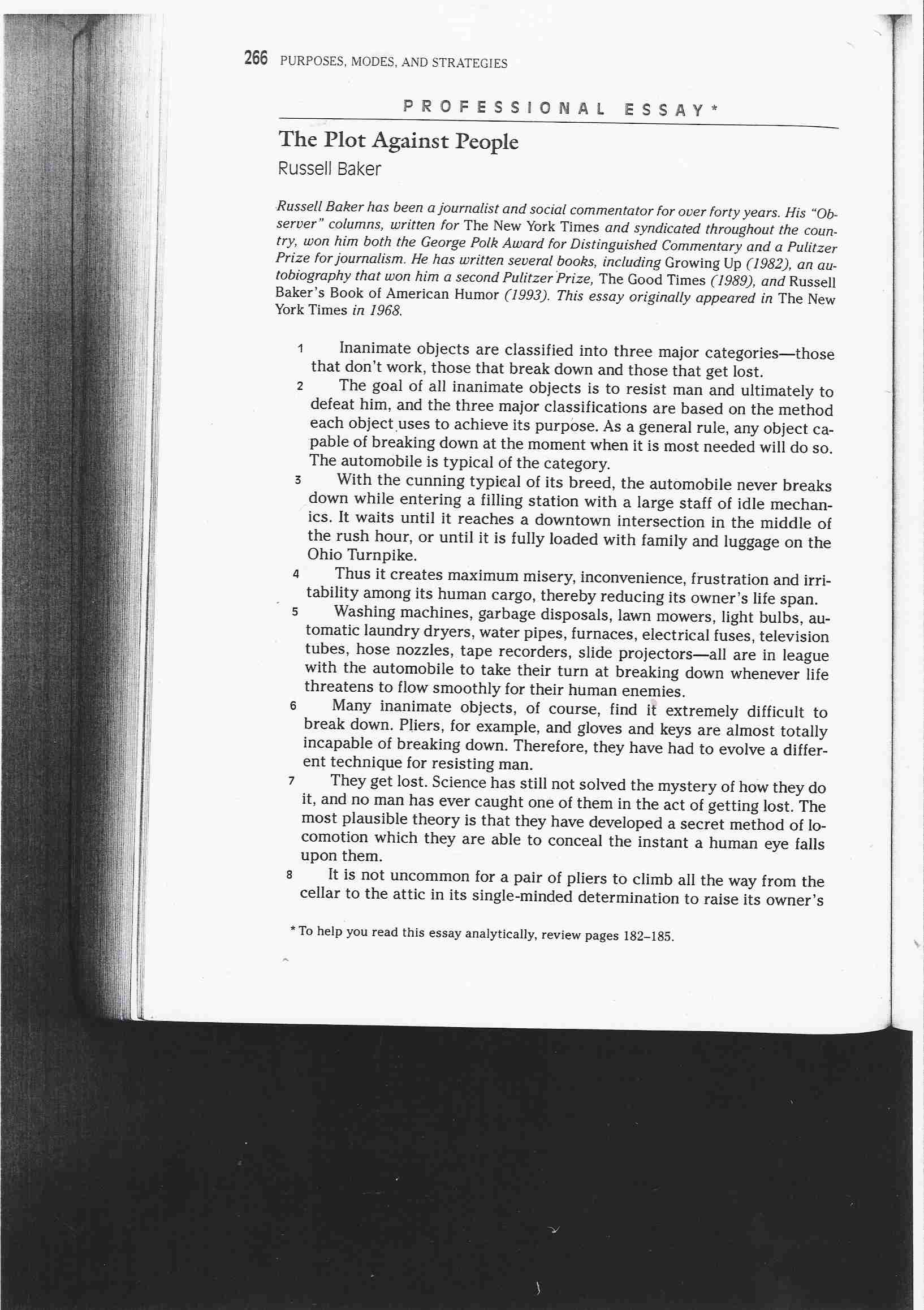writin1

PURPOSES, MODES, AND STRATEGIES
PROFESSIONAL ESSAY*
The Plot Against People
Russell Baker
Russell Baker has been a journalist and social commentator for ouer forty years. His “Ob-seruer” columns, written for The New York Times and syndicated throughout the country, won him both the George Polk Award for Distinguished Commentary and a Pulitzer Prize for journalism. He has written seueral books, including Growing Up (1982), an au-tobiography that won him a second Pulitzer Prize, The Good Times (1989), and Russell Baker’s Book of American Humor (1993). This essay originally appeared in The New York Times in 1968.
1 Inanimate objects are classified into three major categories—those that don’t work, those that break down and those that get lost.
2 The goal of all inanimate objects is to resist man and ultimateiy to defeat him, and the three major classifications are based on the method each object uses to achieve its purpose. As a generał rule, any object ca-pable of breaking down at the moment when it is most needed will do so. The automobile is typical of the category.
3 With the cunning typical of its breed, the automobile never breaks down while entering a filling station with a large staff of idle mechan-ics. It waits until it reaches a downtown intersection in the middle of the rush hour, or until it is fully loaded with family and luggage on the Ohio Turnpike,
4 Thus it creates maximum misery, inconvenience, frustration and irri-tability among its human cargo, thereby reducing its owner’s life span.
5 Washing machines, garbage disposals, lawn mowers, light bulbs, au-tomatic laundry dryers, water pipes, furnaces, electrical fuses, television tubes, hose nozzles, tape recorders, slide projectors—all are in league with the automobile to take their turn at breaking down whenever life threatens to flow smoothly for their human enemies.
6 Many inanimate objects, of course, find it extremely difficult to break down. Pliers, for example, and gloves and keys are almost totally incapable of breaking down. Therefore, they have had to evolve a differ-ent techniąue for resisting man.
7 They get lost. Science has still not solved the mystery of how they do it, and no man has ever caught one of them in the act of getting lost. The most plausible theory is that they have developed a secret method of Io-comotion which they are able to conceal the instant a human eye falls upon them.
8 It is not uncommon for a pair of pliers to climb all the way from the cellar to the attic in its single-minded determination to raise its owner’s
To help you read this essay analytically, review pages 182-185.
Wyszukiwarka
Podobne podstrony:
LanguageA Writing A review i Read and listen. Then answer the questions. 1 What is
Character and personalityGamę Are we the kind of people we are because of the time of the year we we
WRITING Informal letterTOPIĆ Hospitality and foodEXAM TIPS ► Read the task careful
• Forecasting and Strategie Studies Center - Head - dr R. Machnikowski 2.5General description o
Advantages and disadvantages of digital education 25 (for this purpose it is recommended to use the
Selecting SQL Modes The MySQL server can operate in different SQL modes, and can apply these modes d
Błock:Name:ACTIVITY DEMONSTRATION AND NOTES: LAYERS OF THE EARTH Purpose: This is a science demo int
• Forecasting and Strategie Studies Center - Head - dr R. Machnikowski 2.5General description o
CSG208 197 Nouns and Articles One useful strategy to learn the gender of Spanish nouns is to study t
67306668a813cc5c72b4a67222ddf610 Tb<Ele men to ojLegał Writing A GUIDE 10 THE PRIHCIPIES OF WRITI
skanuj0009 (376) Neuroanatomy 9. Spinał Cord.13 Spinał Cord, Topography A Spinał cord and spinał ner
geologia matpom44 Plates and Platę Tectonics 23labie 2-2 - THE LAYERS OF THE EARTH _ &nb
image019 ... if you think that heart disease and stroke hit only the other felloy/s family. No one i
00057 ?3894d9003361260a26a45e7f0f6dd0 56 Hembree & Zirnmer where Gt = P; H’(R< + H P; H’) 1
więcej podobnych podstron